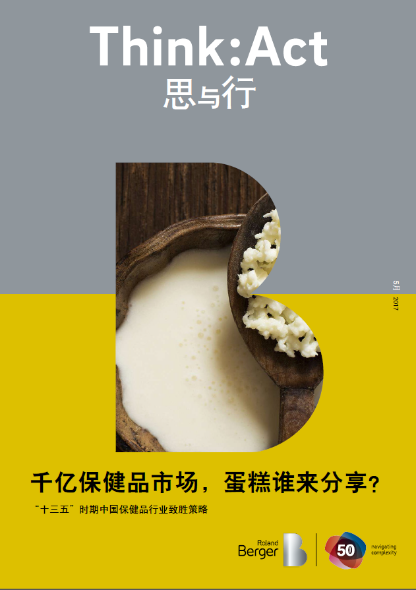Who are going to share the hundred billion nutrition market?
The Winning Strategy for China Nutrition Industry in the 13th Five-Year period and beyond


Roland Berger recently published The Winning Strategy for China Nutrition Industry in the 13th Five-Year period and beyond, a report that analyzes coming opportunities and challenges for the market. Owing to consumption upgrade and advantageous government policies, the size of China's nutrition market is forecast to reach about RMB 180 billion by 2020 from approximately RMB 120 billion in 2015, offering it the potential to replace the US as the largest in the world in the foreseeable future. In response to a rapidly-growing and more regulated market, market players must make strategic preparations in the areas of product development, branding, sales channels and international collaboration.
According to Roland Berger's recent consumer research and industry analysis, China's nutrition market expanded rapidly in its early stages of development and achieved a growth rate of 13% during the decade from 2005 to 2015, faster than that of any other nation. But China is still far behind the US in terms of product penetration rate, ratio of loyal customers and per capita consumption of nutrition products. From 2015 to 2020, the market in China is expected to grow at an annual rate of 8%, driven by four factors: a shift from treatment-focused to prevention-focused, increasing healthcare awareness, rising demand for specialized products and more stringent quality standards. Herbal and traditional products will grow slightly faster than the market as a whole.
On a product level, China's nutrition industry suffers from market fragmentation, insufficient R&D capabilities, weak brand power and insubstantial product influence. However, developments such as the recent positioning of "overall healthcare" as a national strategic goal, the introduction of nutritional product filing system and an expedited processing of direct-sales licenses are driving the market forward and making it more regulated. In the future, high quality and brand power will be critical achieving success in the Chinese market.
As for sales channels, China's nutrition industry has its unique characteristics. Direct-sales and traditional distribution models are expected to co-exist in the foreseeable future, but direct-sales models will still outperform the others in the short term. Driven by cross-border e-commerce and foreign nutrition products, among others, e-commerce has grown considerably in China, replacing pharmacies as the second-largest sales channel. Therefore, traditional off-line channels such as pharmacies need to transform proactively.
Although foreign brands are optimistic about the opportunities to be had in China, their market access is hindered by obstacles to licensing as well as difficulties in sales-channel development and other areas of business. Foreign brands that rely on e-commerce sales also face regulatory challenges including increasing tariffs and the implementation of a pre-approved nutrition products list. Against this background, international collaboration and resources complementation between Chinese companies and foreign brands will become a "New Norm".
As the rapid growth of China's nutrition market is creating unprecedented opportunities and challenges for the industry, companies need to make preparations in the following areas: product development, branding, sales channels and international collaboration.
Companies must gain a comprehensive understanding of consumer trends, position themselves favorably in high-growth market segments, develop individual products with strong recognition and expand product offerings. Strong R&D capabilities will be critical to build specialized brands that focus on specific functions and consumer groups.
One potential strategy for new market players is to enter the market through direct-sales licensing and then leverage e-commerce sales channels for rapid expansion. Meanwhile, traditional off-line channels such as pharmacies should consider making breakthroughs and strategic shifts in a proactive manner.
Local companies should seek out international partnerships in a bid to improve both product quality and brand image. International companies can leverage the advantages of their Chinese partners in policy insight and distribution channels to reap potential economic benefits in the Chinese market at an early date.
The Winning Strategy for China Nutrition Industry in the 13th Five-Year period and beyond